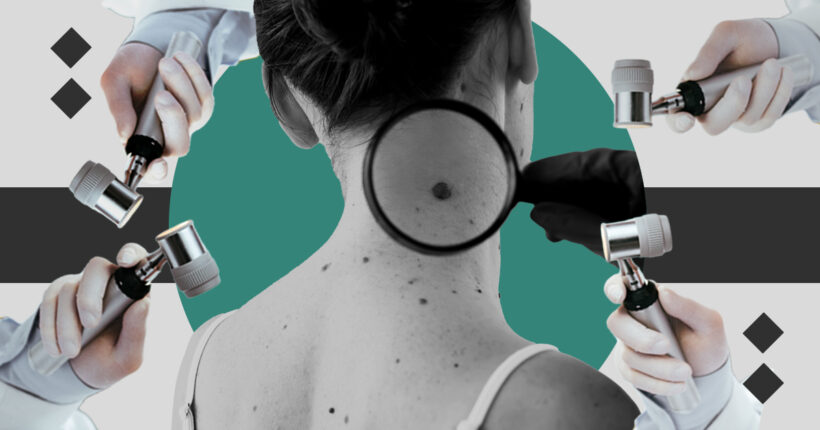
Rubryka, along with "Berezhy Sebe," a Ukrainian platform for evidence-based health information, found out when and how a mole can become a real health risk.
What's the problem?
Almost everyone has moles, and the number tends to increase throughout our lives. Because we've been used to seeing these brown spots on our bodies since childhood, we often don't view a few new ones as dangerous. However, moles, though generally benign, can change due to various factors, developing cancerous properties and turning into melanoma — a type of skin cancer.
According to a study by the World Health Organization (WHO), in 2020, melanoma was diagnosed in 325,000 people worldwide. Sadly, 57,000 patients could not recover and died from this condition. Researchers predict an increase in melanoma cases by 2040. These grim statistics are believed to be due to the rising levels of sun radiation, which causes more cancerous moles.

Global melanoma statistics from 2020 to 2040. Photo: WHO
While people can't control the sun's radiation, reducing the risk of developing melanoma is still possible.
What is melanoma?
Dr. Iryna Krishchenko, a dermatologist, explains that melanoma is the most aggressive malignant tumor that can occur in the human body. In over 70% of cases, it appears on previously clear skin, while the other 30% arises from existing moles. Visually, melanomas can look like spots or nodules with colors ranging from brown to black. There is also a rare type of melanoma without pigment, with light pink to red colors. The doctor notes that these growths must be addressed.
"In the early stages, melanoma doesn't cause any discomfort. A person might not feel anything for a long time. However, if left untreated, melanoma eventually leads to death," Dr. Krishchenko emphasizes.

Dermatologist and member of international medical associations EADV, IDS, EAD, Iryna Krishchenko
Dr. Krishchenko adds that melanoma progresses rapidly, destroying surrounding tissues. It spreads quickly through the body (metastasizes) to various organs, disrupting their functions. The lungs, liver, brain, and bones are often the most affected. Metastases from melanoma can show up with symptoms like:
- Swelling and pain in lymph nodes;
- Difficulty breathing or persistent coughing;
- Bone pain;
- Loss of appetite;
- Headaches;
- Unexplained weight loss.
"Melanoma is a malignant tumor caused by uncontrolled cell division of melanocytes. It happens due to gene mutations inherited from parents or acquired during life. The most common cause of acquired gene mutations is ultraviolet radiation (from the sun or artificial sources like tanning beds)," the expert shares.

Moles on the neck. Image from the internet
Who is at risk?
According to studies by the American Cancer Society, melanoma is more common in older adults, but it also affects younger people, particularly women under 30. In younger people, the disease can be hereditary. Dr. Krishchenko adds that those at higher risk for melanoma include people with:
- Fair skin;
- A large number of moles on their body;
- Multiple dysplastic nevus syndrome;
- A history of sunburns, tanning, or tanning bed visits;
- A previous diagnosis of melanoma, basal cell carcinoma, or squamous cell carcinoma;
- Two or more close relatives diagnosed with melanoma.
What's the solution?
Visit a doctor and do self-examinations
To detect melanoma early, you need to see a dermatologist and have a dermatoscopy. This examination helps identify malignant tumors early and save lives, Dr. Krishchenko says. It is done using a simple magnifying glass or a dermatoscope (an epiluminescent microscope) that makes the top layer of skin transparent.

Doctor examining a mole. Image from the internet
It's also essential to regularly conduct self-examinations of your body to spot early signs of melanoma. You can evaluate suspicious moles using the ABCDE method:
A (ASYMMETRY) — the mole is asymmetrical.
B (BORDER) — the mole has unclear or blurred edges.
C (COLOR) — the mole has uneven coloring, with black, brown, and sometimes reddish or other shades.
D (DIAMETER) — melanomas are often larger than 6 mm in diameter. The diameter of a pencil eraser can be a helpful guide.
E (EVOLVING) — the mole looks very different from the others on your body or is visibly changing.
When should you worry?
However, dermatologist Dr. Kuzma Khobzei says this method doesn't provide a definitive diagnosis; it only indicates potential signs of melanoma. These indicators help people suspect possible risks and seek medical advice promptly.
"There are asymmetrical moles that are completely benign. Sometimes, smaller growths under 6 mm are later diagnosed as melanoma. So, these are just general parameters. What can be most worrying is the mole changing. If a mole grows, changes, or develops sores, that's a very concerning sign," he explains.

Dermatologist Kuzma Khobzei. Image from the internet
There is also a popular myth that scratching a mole will cause melanoma. Dr. Khobzei says that's not true.
"A one-time injury to a healthy mole won't cause cancer. After all, a mole is just part of the skin. If a mole gets badly damaged from minimal contact, that's likely because it's already breaking down. However, consistent trauma to a mole, even a healthy one, can be dangerous. If you have a mole in a spot where it gets hurt a lot, you should discuss with a dermatologist-oncologist the possibility of removing it," Dr. Khobzei explains.
If a mole raises concern, you should see a doctor without delay. The experts interviewed by Rubryka suggest that everyone should undergo regular check-ups at medical facilities. Your family doctor or dermatologist should determine the frequency of these visits. They can assess your skin's condition and family history, which helps determine the optimal number of visits per year. These regular check-ups can detect melanoma at an early stage and reduce the risk of fatal outcomes.
How is melanoma treated?
When melanoma is diagnosed early, it can be treated through surgery, usually with local anesthesia. If melanoma hasn't spread to the lymph nodes, patients recover in 99% of cases.
"When melanoma spreads throughout the body, additional treatment methods are required. These include chemotherapy, radiation therapy, and adjuvant immunotherapy," says Dr. Krishchenko.
Dr. Kuzma Khobzei adds that immunotherapy drugs help the body's immune system fight cancer. However, this treatment is expensive, and Ukraine has no government programs covering the costs.
Even if melanoma is diagnosed at a later stage, it doesn't mean it can't be treated. In these cases, the therapy will be more complex and take longer.
Even more helpful solutions
How can you prevent melanoma?
The greatest risk for melanoma comes from ultraviolet radiation. It leaves behind favorable conditions for mole development and transformation into cancerous growth. You can reduce the risk of melanoma by following these simple recommendations:
- Avoid tanning, sunburns, and tanning beds. If you can't resist tanning, avoid the sun during its peak hours — between 10 a.m. and 4 p.m. — and follow the second recommendation.
- From March to October, apply sunscreen with SPF 50+ to all exposed skin. It's advised to use sunscreen even on cloudy days and reapply it every two hours, especially when swimming or sweating.
- Wear hats and sunglasses during the summer. To block the sun's rays, cover as much of your body as possible with cotton or linen clothing.
- Undergo preventive exams with a dermatologist at least once a year.
Following these simple rules and the ABCDE self-examination method will help you prevent the risk of melanoma and stay healthy. You should be especially careful now, as ultraviolet radiation is increasing with the approach of summer.








